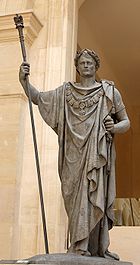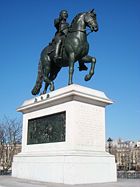
François-Frédéric Lemot
Encyclopedia

Neoclassicism
Neoclassicism is the name given to Western movements in the decorative and visual arts, literature, theatre, music, and architecture that draw inspiration from the "classical" art and culture of Ancient Greece or Ancient Rome...
.
Biography
Lemot was born at LyonLyon
Lyon , is a city in east-central France in the Rhône-Alpes region, situated between Paris and Marseille. Lyon is located at from Paris, from Marseille, from Geneva, from Turin, and from Barcelona. The residents of the city are called Lyonnais....
.
Having briefly studied architecture at the Academy of Besançon
Besançon
Besançon , is the capital and principal city of the Franche-Comté region in eastern France. It had a population of about 237,000 inhabitants in the metropolitan area in 2008...
, then having made his way to Paris on foot, the adolescent Lemot was discovered sketching a sculpture of Pierre Pujet in the park of Sceaux
Château de Sceaux
The Château de Sceaux is a grand country house in Sceaux, Hauts-de-Seine, not far from Paris, France. Located in a park laid out by André Le Nôtre, it houses the Musée de l’Île-de-France, a museum of local history. The former château was built for Jean-Baptiste Colbert, Louis XIV's minister of...
and taken into the atelier of Claude Dejoux, a minor Neoclassical sculptor who had trained with Guillaume Coustou the Younger
Guillaume Coustou the Younger
Guillaume Coustou the Younger was a French sculptor.The son of Guillaume Coustou the Elder and nephew of Nicolas Coustou, he trained in the family atelier and studied at the French Academy in Rome, 1736–39, as winner of the Prix de Rome...
. At the age of seventeen he won the Prix de Rome
Prix de Rome
The Prix de Rome was a scholarship for arts students, principally of painting, sculpture, and architecture. It was created, initially for painters and sculptors, in 1663 in France during the reign of Louis XIV. It was an annual bursary for promising artists having proved their talents by...
for sculpture in 1790, with a bas-relief of The Judgement of Solomon, and became a pensionnaire at the French Academy in Rome
French Academy in Rome
The French Academy in Rome is an Academy located in the Villa Medici, within the Villa Borghese, on the Pincio in Rome, Italy.-History:...
, where his stay was interrupted in 1793 by a call to the Army of the Rhine
First Coalition
The War of the First Coalition was the first major effort of multiple European monarchies to contain Revolutionary France. France declared war on the Habsburg monarchy of Austria on 20 April 1792, and the Kingdom of Prussia joined the Austrian side a few weeks later.These powers initiated a series...
. Two years later he was recalled to participate in a competition under a committee of the National Convention
National Convention
During the French Revolution, the National Convention or Convention, in France, comprised the constitutional and legislative assembly which sat from 20 September 1792 to 26 October 1795 . It held executive power in France during the first years of the French First Republic...
for a colossal bronze sculpture of The French People in the guise of Hercules; his model was judged to be the best, however the monument was never commissioned. His first showing at the Paris Salon
Paris Salon
The Salon , or rarely Paris Salon , beginning in 1725 was the official art exhibition of the Académie des Beaux-Arts in Paris, France. Between 1748–1890 it was the greatest annual or biannual art event in the Western world...
was in 1801.
Under the Empire he was commissioned to sculpt the chariot and figure of Fame in the quadriga
Quadriga
A quadriga is a car or chariot drawn by four horses abreast . It was raced in the Ancient Olympic Games and other contests. It is represented in profile as the chariot of gods and heroes on Greek vases and in bas-relief. The quadriga was adopted in ancient Roman chariot racing...
atop the Arc de Triomphe du Carrousel
Arc de Triomphe du Carrousel
The Arc de Triomphe du Carrousel is a triumphal arch in Paris, located in the Place du Carrousel on the site of the former Tuileries Palace. It was built between 1806 and 1808 to commemorate Napoleon's military victories of the previous year...
that stood in front of the Tuileries Palace
Tuileries Palace
The Tuileries Palace was a royal palace in Paris which stood on the right bank of the River Seine until 1871, when it was destroyed in the upheaval during the suppression of the Paris Commune...
, for which the horses were the Greek bronze horses removed by Napoleon from St. Mark's, Venice. He was elected to the Académie des Beaux-Arts de l'Institut de France
Académie des beaux-arts
The Académie des Beaux-Arts is a French learned society. It is one of the five academies of the Institut de France.It was created in 1795 as the merger of the:* Académie de peinture et de sculpture...
in 1805, then named a member of the Institut de France, 1805, then to the Legion of Honor and presented with the Ordre de Saint-Michel and the title of Baron of the Empire.

Bourbon Restoration
The Bourbon Restoration is the name given to the period following the successive events of the French Revolution , the end of the First Republic , and then the forcible end of the First French Empire under Napoleon – when a coalition of European powers restored by arms the monarchy to the...
, Lemot was entrusted with the recasting of the equestrian monument to Henri IV
Henry IV of France
Henry IV , Henri-Quatre, was King of France from 1589 to 1610 and King of Navarre from 1572 to 1610. He was the first monarch of the Bourbon branch of the Capetian dynasty in France....
that had been destroyed during the Revolution. Two sculptures of Napoleon, melted down for the occasion, provided the bronze, and the cast was taken from a mold of a surviving cast of the original. Lemot also provided the bronze bas-relief panels for its pedestal; the sculpture (illustration) was unveiled 25 August 1818. Lemot also provided an Equestrian Monument of Louis XIV that provides the focal point of Place Bellecour
Place Bellecour
The Place Bellecour is a large town square in Lyon, France, to the north of the Ainay district. Measuring 312 m by 200 m , it is the largest clear square in Europe, and the third biggest square of France, behind the place des Quinconces in Bordeaux et the place de la...
, Lyon, where a street bears his name. At 18 meters, it was the largest bronze casting of its time.
With the considerable fortune he had earned, Lemot bought the Château de Clisson
Clisson
Clisson , is a commune in the Loire-Atlantique département in western France.It is situated at the confluence of the Sèvre Nantaise and the Moine southeast of Nantes ....
in western France
France
The French Republic , The French Republic , The French Republic , (commonly known as France , is a unitary semi-presidential republic in Western Europe with several overseas territories and islands located on other continents and in the Indian, Pacific, and Atlantic oceans. Metropolitan France...
, in the département of Loire-Atlantique
Loire-Atlantique
Loire-Atlantique is a department on the west coast of France named after the Loire River and the Atlantic Ocean.-History:...
(Pays de la Loire
Pays de la Loire
Pays de la Loire is one of the 27 regions of France. It is one of the regions created in the late 20th century to serve as a zone of influence for its capital, Nantes, one of a handful so-called "balancing metropolises" ¹...
), and the town, which had been destroyed during the Revolt in the Vendée
Revolt in the Vendée
The War in the Vendée was a Royalist rebellion and counterrevolution in the Vendée region of France during the French Revolution. The Vendée is a coastal region, located immediately south of the Loire River in western France. The uprising was closely tied to the Chouannerie, which took place in...
, was rebuilt according to his plans. He published a Notice historique sur la ville et le château de Clisson, or Voyage pittoresque dans le Bocage de la Vendée, 1817.
His pupil, Louis Dupaty
Louis Dupaty
Louis-Marie-Charles-Henri Mercier Dupaty was a French sculptor.The eldest son of the magistrate Jean-Baptiste Mercier Dupaty and brother of the writer and académicien Emmanuel Mercier Dupaty, he was destined for the magistrature but preferred the arts...
, obtained a Premier Grand Prix in sculpture, 1799, with his Pericles visiting Anaxagoras. On his return from the French Academy in Rome
French Academy in Rome
The French Academy in Rome is an Academy located in the Villa Medici, within the Villa Borghese, on the Pincio in Rome, Italy.-History:...
he was named to the Institut de France
Institut de France
The Institut de France is a French learned society, grouping five académies, the most famous of which is the Académie française.The institute, located in Paris, manages approximately 1,000 foundations, as well as museums and chateaux open for visit. It also awards prizes and subsidies, which...
, in 1816, then appointed a professor at the École des Beaux-Arts
École des Beaux-Arts
École des Beaux-Arts refers to a number of influential art schools in France. The most famous is the École nationale supérieure des Beaux-Arts, now located on the left bank in Paris, across the Seine from the Louvre, in the 6th arrondissement. The school has a history spanning more than 350 years,...
. The most famous sculptor to emerge from Lemot's studio was Lorenzo Bartolini
Lorenzo Bartolini
Lorenzo Bartolini was an Italian sculptor who infused his neoclassicism with a strain of sentimental piety and naturalistic detail which led him furthermore in the future, while he drew inspiration from the sculpture of the Florentine Renaissance rather than the overpowering influence of Antonio...
.
Lemot died at Paris in 1827.
Selected works
- Numa Pompilius Lycurgus and Brutus for the Chambre de Conseil des Cinq Cent, Assemblée Nationale.
- Léonidas for the Chambre des Pairs.
- Figures for the triumphal arch at Châlons-sur-Marne, destroyed by the Allies in 1814.
- Cicero addressing Catiline, over lifesize.
- Sleeping Woman, statue.
- Napoleon in Triumph (1808), lead, (Musée du Louvre). This standing figure stood briefly in the quadriga of the Arc du Carrousel.
- Equestrian Henri IV (1817), bronze. The sculpture on the Pont NeufPont NeufThe Pont Neuf is, despite its name, the oldest standing bridge across the river Seine in Paris, France. Its name, which was given to distinguish it from older bridges that were lined on both sides with houses, has remained....
, Paris, reproduces the work designed by GiambolognaGiambolognaGiambologna, born as Jean Boulogne, incorrectly known as Giovanni da Bologna and Giovanni Bologna , was a sculptor, known for his marble and bronze statuary in a late Renaissance or Mannerist style.- Biography :...
and completed by Pietro TaccaPietro TaccaPietro Tacca was an Italian sculptor, who was the chief pupil and follower of Giambologna. Tacca began in a Mannerist style and worked in the Baroque style during his maturity.-Biography:...
, 1618. - Louis XIV, bronze, Lyon, Place BellecourPlace BellecourThe Place Bellecour is a large town square in Lyon, France, to the north of the Ainay district. Measuring 312 m by 200 m , it is the largest clear square in Europe, and the third biggest square of France, behind the place des Quinconces in Bordeaux et the place de la...
- Allegorical bas-relief, the bust of Liberty between seated figures of History and Fame, in white marble against a porphyryPorphyry (geology)Porphyry is a variety of igneous rock consisting of large-grained crystals, such as feldspar or quartz, dispersed in a fine-grained feldspathic matrix or groundmass. The larger crystals are called phenocrysts...
ground, for the Chambre des Deputés.

